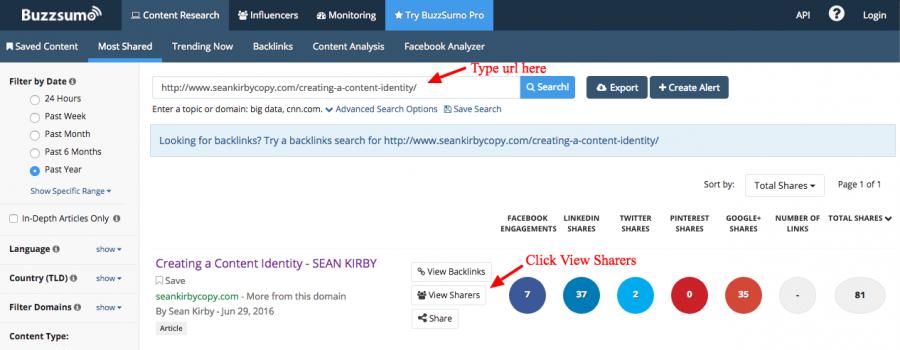How To Get More Mileage Out Of The Content You Already Have
By Sean Kirby
_on_Honda_Insight.png)
Raise your hand if you’ve heard this before (Not literally. That would be weird since I can’t see you):
If you want more traffic, you need more content.
That can work. But it’s easier said than done. Don’t fret. I’m going to show you 4 ways to get the same results using the content you already have.
Get more people to view your content with this dead-simple strategy.
Most people publish their content, promote it in all the usual places and then move on to the next thing. Sound familiar?
Here’s the problem though. Not everyone is going to see it. Some might be busy that week. For others, the timing may not be right for that particular topic.
The solution is dead simple.
Re-promote your evergreen content. You can use a tool like Edgar to automatically requeue content in your social media feeds. Or you could do everything manually by setting up reminders on a recurring basis, such as every three months.
Each new pass is another opportunity to bring in traffic, build backlinks and engage your target audience. Not bad for something that takes only a few minutes.
Get published on multiple sites without guest blogging.
Writing content for authority sites is a great way to reach new people, build your brand and generate leads. But it’s also time consuming. Luckily guest blogging isn’t the only way to get published on another website.
I’m talking about content syndication. Sites like Huffington Post, Lifehacker and many others regularly publish content that originally appeared elsewhere. Just imagine what getting on one of those sites could do for you.
Content syndication is a big part of Buffer’s content promotion strategy. As an example, this article on content length got 6,000 additional social shares after Fast Company republished it on their site.
Here’s how you can get sites to syndicate your content.
-
Identify syndication opportunities.
There are three things that you are looking for at this stage:
The site accepts syndicated content. The site attracts a large number of people in your target audience. And the site is a good fit for your content.
Google is a good place to start your search. Type in your topic or keyword, plus “originally published on” to find sites that have already published syndicated content.

Another variation is to search for content originally published on a specific site, such as a competitor or a company that shares your target audience. For example:

When you have a good list of potential sites, check their traffic with Alexa or a similar site and the audience engagement. Many sites include a count by the share buttons. Checking how many comments they receive can be another indicator of how engaged their audience is.
Prioritize your list based on all these indicators. Then you are ready for the next step.
-
Find the right person to contact.
Once you know which sites may be interested in syndicating your content, you need to reach out and ask. Here’s how:
First, determine the right person to contact. Is there an editor for the specific topic area you are interested in? If not, is there a particular writer on that site’s staff who covers that topic? If you can’t find it on the site, try LinkedIn.
If all else fails, reach out to the site and ask who you should contact. You can usually find a phone number or at least a form on the site’s contact page.
Next, you need to find that person’s contact information. Again, check the site to see if it’s listed there. Here are a few other strategies you can try:
- Check LinkedIn to see if you have a mutual connection who can introduce you.
- Use a service like io or Voila Norbert.
- Guess what the person’s email might be. Most emails within a company tend to follow the same format, so you may be able to take an educated guess.
-
Send your pitch.
Now you’re ready to actually write your pitch. Follow these tips for best results.
Personalize your email. I’m not just talking about including the person’s name. I mean mentioning some bit of information that demonstrates this isn’t some form email sent to hundreds of sites. This could be as simple as mentioning a particular article they posted and some specific aspect of it.
Get to the point quickly and keep it concise. These people are busy and get a lot of emails. They are going to decide whether to read or delete yours in a matter of seconds, so don’t waste any words.
When you make your request, be sure to mention what’s in it for them. Why is your content a good fit? How will it help their readers? Make sure to only pitch your best stuff.
Try to prove your value. Anything going on their site reflects on them. So they want to know that your content is as good as you claim. You can mention other big sites you’ve written for or big wins from your own site.
The process doesn’t end when your content is posted. Be sure to send a thank you note and let the editor know that you are sharing the piece on your social channels.
After a website has syndicated your content a couple of times and you’ve established yourself as a credible source of content, reach back out and offer a direct feed to your content. This can help you to become a regular contributor for minimal effort.
Double your content creation in half the time (or less).
I admit you actually are creating new content with this strategy. But you’re not working from scratch. You’ve already done all the hard work. You just have to repackage your content into another format.
For example, Groove created an ebook out of some of the most popular posts from their Startup Journey blog.
Rand Fishkin created this awesome Slideshare presentation and Whiteboard Friday video out of the same topic.
The folks over at Internet Business Mastery started recording a few of their most popular blog posts for their podcast. Those audio blog posts get 60% - 100% more downloads than their feature podcast.
There are several benefits to repurposing your content.
By appealing to individual learning styles and preferences, you can reach people who otherwise wouldn’t be interested.
And you’ll be more persuasive to those who consume the content in more than one format. Studies show that people believe information more when it’s repeated.
You could also boost your SEO. More content related to your keywords means more opportunities to earn backlinks. Be sure to include internal links within your content to give juice to your most important pages on that topic.
Now that you know the “what” and the “why” of repurposing your content, it’s time to focus on “how.”
-
Choose the right content.
Dig through your analytics to identify your best performing pieces. This could be based on your SEO traffic, number of shares, leads generated or any other metric you want to focus on. These metrics are a good indicator of how well your repurposed content should perform.
Once you’ve identified these proven winners, eliminate anything tied to a particular event or date. By the time you have measurable results on these, it is usually already be too late to repurpose. You want to be able to maximize the shelf-life of this content.
-
Choose your new format.
Consider what types of content your target audience prefers, what your goals are and how your content will translate into the new format. For instance, it makes sense to use blog posts as chapters of an ebook, because they are both text-based.
-
Adjust for the medium.
You wouldn’t want to use a blog post as is for a Slideshare presentation. Nobody would want to read all that text in that format. It would be much more effective to pull out subheads and quotes and even add new images.
Take another look at the example from Rand Fishkin above. He doesn’t simply copy and paste from one format to another. He presents his story in ways that take advantage of the strengths of each.
Make your content instantly more appealing to search engines and readers.
Readers and search engines love fresh content. And it makes sense. Newer content is more likely to include more current and accurate information.
There’s one thing you may be forgetting, though.
Fresh doesn’t have to mean brand new. Updating older blog posts is a great way to deliver fresh content. In fact, in many ways, it’s even better. You already have a good chunk of the writing done, a benchmark of performance, and a list of people who have shared this before.
To get the most bang for your buck, prioritize content that ranks on the bottom of the first page to the second page of Google or your preferred search engine. Here’s why.
Take a look at this chart.

Moving up a few spots on the first page or going from the second page to the first will have a far greater impact than moving up from a deeper page. Once you’ve identified this content, check the search traffic. Moving to the first page won’t do much for you if no one is searching for that term.
Now that you’ve found some good content to work with, it’s time to get updating. Check for any broken links or outdated sources that need to be replaced. Make sure the messaging is up-to-date with the latest trends and best practices. Include new internal links where appropriate.
But that’s just the start. If you want to improve your ranking you need to go beyond simple updates. You need to find ways to add more value. Provide more detail. Add new information. Make the content easier to read and understand. Make it more actionable.
Brain Dean saw a 292.54% jump in organic traffic after implementing several enhancements to one of his older posts. Among other things he added a case study, answered questions he noticed readers asking, included some storytelling and added bonus elements.
Including the date the article was last updated was another smart tactic you can pick up from this example.
Don’t forget to update your meta description as well. Look at the top results for your search term as well as the paid ads for words and phrases that catch reader’s attention and persuade them to click.
Finally, be sure to promote your newly updated content. In addition to all your usual methods, leverage the built-in audience you have from the first time you published this piece. Here’s how:
Use Buzzsumo to get a list of people who shared your original article. Then reach out and ask if they’d like to share the update.

Use your favorite backlink checker to see who is linking to your article and give them a head’s up about the update. Since they linked to it the first time, they may want to share it this time, too.
Contact everyone who left a comment on your original article and let them know about all the improvements and new information you added.
Over to You.
Have you had any success with these strategies? Are there other ways to get more out or your content that I haven’t mentioned? Share your thoughts, comments and questions.
About the author
Sean Kirby is an award-winning copywriter and content strategist whose writing has helped generate millions of dollars in sales for his clients. When he’s not writing about himself in the third person, you can find him helping clients boost web traffic, improve conversion rates and increase sales.
Get a FREE evaluation of any project you choose, and Sean will give you actionable feedback worth thousands of dollars. Hurry, before he comes to his senses.
Feature ingage by Wiki-ny-2007 (Own work) [CC BY-SA 4.0], via Wikimedia Commons
Your Social Outsource Team
The team at Social Hire won't just do social media management. Our team work closely with your team to ensure your business sees great value from the service and that your team gets tangible results.
Our digital marketing managers are the wizards that can give you the insight you need to grow your business. Have you had enough of making difficult personnel choices that don't work well for your online marketing?
The social media marketers in our company are the best in the business at helping our partners enhance their online marketing. We outline and implement cutting-edge social media marketing plans that help our customers realise their organisational objectives and further their social media presence. Our experienced team of digital experts do your social media strategy creation and management in an uncomplicated monthly plan that is cost-effective and is genuinely useful, whatever results you demand from your online marketing management.
Our group of specialists are an organisation that helps our clients boost their online marketing by offering social media management services on a monthly basis.
You might like these blog posts How To Engage Your Customers On Facebook, Why Your Business Needs Marketing Automation, Talent Mobility Will Make You See the Importance of Employee Happiness, and The 2nd P&L – What is Making Your Competitors More Successful Than You.
